|
|
|
|
|
|
PIERRE-FRANÇOIS BRIAND, Sieur de la Villeroux,
was born in Paramé, France, on 07-09-1708.
He was Captain of merchant ships and a naval carpenter. At his 22 years old he went to live to the French Acadia (where today is located Nova Scotia), with his elder brother, Laurent. |
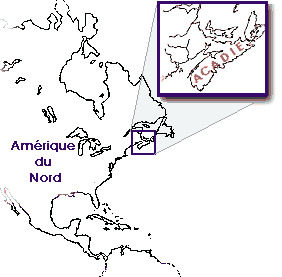 |

|
|
Since the 13th Century, it was a costume at Saint Malo and nearer villages, as Paramé, to deliver around 30 mariners every year for the fishing in Newfoundland. For the French villages of Brittany, mainly based on agricultural resources, this task helped to duplicate the homeland incomes. The wife used to keep in charge of the house, the children, the cultures and the cattle, while the husband came back home with an interesting extra income, obtained from the sales of the fishing. Along the times, many young navigators, before getting married, decided to stay at the coasts of Canada, and to start a new life on there. |
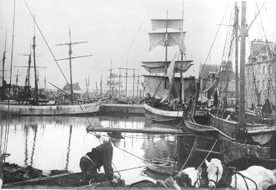 |
|
ACADIA. We might say that Acadia is today a Nation without territory. Acadians are a culture, a history, a way of living and the feeling of a Nation. Originally, was founded in 1604 by the first French colons arrived to North America, on the area in which today are located the Canadian provinces of Nova Scotia and New Brunswick. When Pierre Du Gua de Mons arrived with 80 men, amongst them the cartographer Samuel de Champlain to the Île Sainte-Croix, the land was already inhabited by thousands of years by the Micmac and Abenaki Indians, who soon became friends and allies of the colons. In 1605 de Mons and Jean de Poutrincourt founded Port Royal, (actually Nova Scotia) which will be the first French permanent establishment in North America, and the capital of Acadia for more than one century. Since 1613, when the first English attack is produced, Acadians are frequently aggressed by England. The Englishmen were interested in the great fishing industry of the zone and in the agricultural and cattle's development that Acadians were obtaining, along with an important commerce of furs. Since 1630 a huge number of French colons arrived and Port Royal grows in importance. Acadia is part of a vast colonial empire named the Nouvelle France being its capital Quebec, but retains its own administration and autonomy, with center in Port Royal. From 1690 the English attacks were each time more intense (the Englishmen were the neighbors at the American colonies and France was too far to defend them) until in, by the Treaty of Utrecht en 1713, France gives up to England all the Hudson Bay, Acadia and Newfoundland. Only keeps the closer French colonies of Île Saint-Jean and Île Royale. France then needs to consolidate its presence on the region to protect its important fishing industry, and founded at the Île Royale, (currently Cap Breton) a solid military fortress: Louisbourg. The construction labor in Louisbourg starts in 1720. And it will fall down forever under British dominion in 1758 . |
|
 |
|
|
|
Louisbourg grows rapidly and very soon it becomes the third village of Nouvelle France. The first lighthouse of North America was settled on its coasts. PIERRE-FRANÇOIS BRIAND is recorded at that time in a Census as Carpenter and Navigator. His brother LAURENT, also recorded as navigator, went to live at Nouvelle-France in 1734, and, at Lévis, Quebec, on September 23rd. 1737, he married Marguerite DUQUET dit Desrochers, born April 5 1702, widower of Jean-Baptiste Hallé, and daughter of Jean Duquet dit Desrochers and Catherine-Ursule Amyot. Two children born of this marriage died at young age: Marie-Joseph (8/12/1738 - 24/12/1738) and Charles-Laurent (25/10/1741 - 11/10/1748). After living at Lévis some years, Laurent Briand settles on rue Saint-Jean at Québec, where he resides with his wife until 1748. After this date, the couple Briand-Duquet is not more mentioned in Nouvelle-France. ------------------------- IN 1745 LOUISBOURG FALL DOWN UNDER BRITISH DOMINION AND IS RESTORED TO FRANCE IN 1748. Finally, Pierre-François Briand died in Louisbourg in 1750, being 44 years old.
Our Briand Genealogy continues with Georges Cyprien Briand. To see the rest of his siblings' descendants , click here. |
| 1755: The Deportation of the Acadians (Le Grand Dérangement) | ||
|
|
En 1755 Pierre-François family witnessed one of the sourest moments of the Acadian History. At the beginning of the 7 Years War, Acadians were pressured by the British forces of occupation, under the threat of deportation, to render the Oath of Allegiance to the King of England. Until that moment existed a pact of neutrality with the French population of the area. Acadians refused to render the Oath, and then their houses, land, cattle and ships were forfeited to the British Crown, being 12,600 of them (on a total population of 13,500) deported on unhealthy and overcrowded vessels to France, England and North America. |
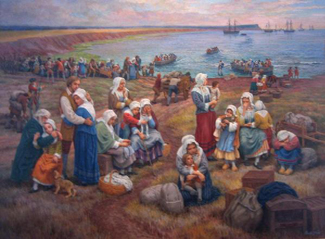 |
| Nevertheless, those deportations of 1755 would not affect yet directly Renée Marchand, Pierre-François widow, and her 9 children. But three years later, in 1758, during another of the episodes of the 7 Years War, takes place the Siege of Louisbourg and the village falls down definitively under British domination. |
| 1758: The Siege of Louisbourg | ||
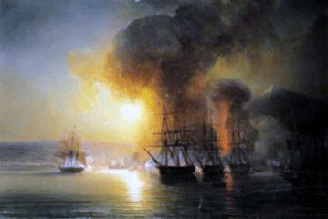 English fleet on Louisbourg, 1758 |
In June of 1758 an impressive british fleet, with 50 vessels, 13,000 men and 150 canons, at the command of Admiral Boscawen sieges by a month and a half to Louisbourg, and after a hard battle they bomb the village, destroying houses, farms, and ships with a balance of more than 1,500 dead and wounded. On July 27th Gral. James Wolfe takes definitively possession of the village |
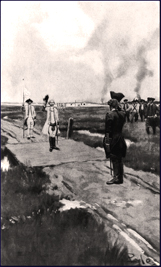 Capitulation of Louisbourg |
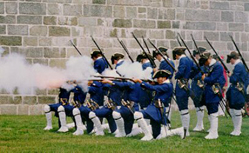 |
||
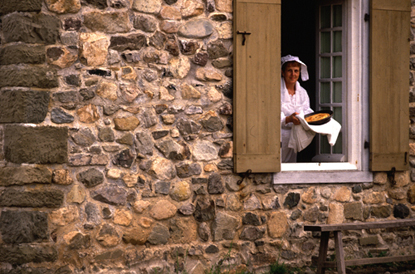 |
The family Briand-Marchand emigrates, first, to the Isle of Saint Jean and then they are deported, after the British occupation on the Island, in December 1758 to La Rochelle ,France. There is a marriage recorded in Rochefort, of the Pierre-François' first daughter, Jeanne, in 1762. By the Treaty of Paris of 1763, which signs the end of the 7 Years War, France ceded all its possessions in Canada to England, only retaining dominion on the Isles of Saint Pierre et Miquelon. The Family Briand-Marchand is still living in Rochefort in 1764,because that year a Celestin Briand's marriage is recorded there. En 1765 they are all back in Miquelon, cause that year the first Celestin's son was born there, and the same year, his siblings Joseph y Nicholas-François are married on Miquelon, too. Renée Marchand died in the Isle of Miquelon on October 31st. 1784, being 76 years old. |